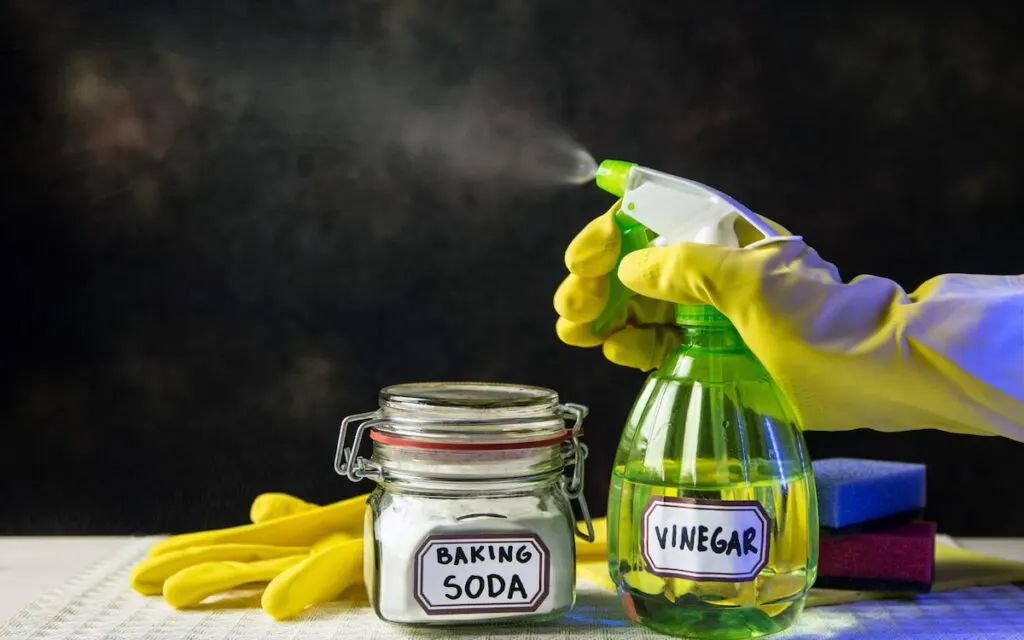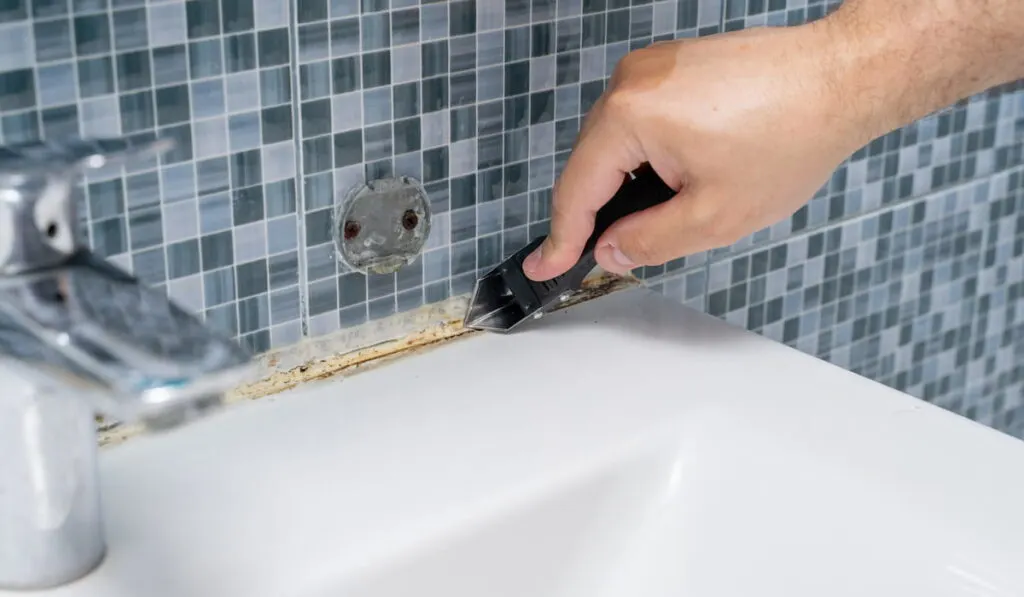*This post may have affiliate links, which means I may receive commissions if you choose to purchase through links I provide (at no extra cost to you). As an Amazon Associate, I earn from qualifying purchases. Please read my disclaimer for additional details.
Tiles add glamor to our floors and walls. But the grout between your tiles can become discolored and unsightly if you don’t clean them well.
Grout attracts dirt, grime, and grease stains, not to mention mold in damp areas. And as the saying goes, failure to mend a crack may cost you the wall.
Getting your grout clean can be a daunting task, especially if you lack the right tools. It becomes more difficult when stained.
But what do you need to keep your tiles sparkling? If this is your concern, we have a solution.
This comprehensive guide highlights what you will need to clean grout and the steps to follow for a sparkling finish.

Table of Contents
What Do I Need to Clean Grout?
In addition to water and detergents, you need the following to clean grout.
1. Grout Eraser
Your floor and wall tiles are prone to grease stains from grease and other spilled substances. Whereas some are removable using liquid detergents, some can be quite stubborn to remove.
You need a grout eraser to help you remove stubborn stains before wiping the rest of the surface.
Various grout erasers are available in the market.
Whenever you are cleaning grout, try different erasers and choose the one that works best on your tiles.
Some stain removers can bleach colored tiles, making them lose their glamor. Therefore, use them sparingly and only when your grout has stubborn stains.
2. Mold Remover
Mold infestation is common on damp surfaces in your house. The commonly affected areas include tiled walls near your kitchen sink and in your bathroom.
Prolonged exposure to the musty smell in mold-infested areas exposes you and your loved ones to many health issues. Eye irritation, sore throat, skin irritation, and headache are among the effects of mold on your health.
Thanks to mold removers in the market, you only need to spray the affected areas and leave it alone for 30 minutes before scrubbing.
Once all the mold is loose, you can wash away the debris using clean water. You can also use homemade mold remover by mixing four parts of water with one part of bleach.

3. Vinegar Spray
You can use bleaching agents to clean grout, but not in all areas of your house. That is where a vinegar spray comes in.
If you have a septic tank for your house, you should not use bleach when cleaning tiles and grout. The bleach kills the bacteria needed to break down the sludge in your septic.
The great thing though, distilled white vinegar can do the trick by:
- Whitening grout and tiles.
- Killing germs to make your tiled surfaces safer, especially for toddlers.
Note that white distilled vinegar is safer than chlorine bleach and equally effective.
4. Whitening Toothpaste
Whitening toothpaste comes in handy when you don’t have vinegar and other bleaching agents.
If you observe black marks on the grout and along the tile edges, you can remove them using whitening toothpaste.
Squeeze some toothpaste on the surface of your brush and scrub the grout and tile edges with it.
The areas covered with black marks change to white in no time. After restoring the grout color, you can rinse the debris off using warm water.
5. An Absorbent Sponge
You should keep grout moisture free after cleaning.
An absorbent sponge helps you clean grout while absorbing moisture and small dirt particles. This prevents accidents from slippery floors while also keeping mold at bay.
After applying the cleaning solution and scrubbing, you can wipe the loose debris using the sponge.
Depending on the size of the area you are cleaning, you should rinse the sponge periodically. This helps prevent leaving dirt from other areas on your tile edges.
6. Bicarbonate of Soda (Baking Soda)
Also known as sodium hydrogen carbonate, bicarbonate of soda is a mild abrasive you can use in grout cleaning. This solution loosens dirt without scratching your tiles, leaving them shiny and elegant.
Why should you choose the bicarbonate of soda?
- It is a safe deodorizer.
- It’s gentle on your tiles.
- It is less costly.
- It saves time since it removes dirt faster.
To use this abrasive, add one part of water to two parts of sodium bicarbonate and make a paste.
Using a brush or an electric toothbrush, rub the paste onto the dirt. Let it rest for a few minutes before rinsing it with warm water.
7. Hydrogen Peroxide
Hydrogen peroxide is a natural neutral cleaner. When you apply it to grout, the solution forms an oxygenated bleach that clears stains without discoloring your tiles.
The solution is simple to prepare.
Mix equal volumes of 3% hydrogen peroxide and clean water in a spray bottle. Shake the mixture and spray evenly on the grout.
Let the grout rest for an hour before washing the solution off using warm water.
Wipe with an absorbent sponge when clean.

8. Grout Brush
A grout brush is designed to reach hidden and hard-to-reach areas. It has extra-stiff, angle-cut bristles suitable for reaching all areas of your grout.
The grout brush is made of stainless steel and polypropylene. These materials are resistant to bleaches and other solutions used in grout cleaning, making it last longer.
How to Clean Grout in 4 Steps
Here are 4 steps you should follow when cleaning grout.
Step 1
Mix one part of water with two parts of bicarbonate of soda. Apply the mixture to the grout while scrubbing.
You can use an old toothbrush or an electric one to scrub.
Let the grout rest for about one hour to allow the bicarbonate mixture to loosen and remove all dirt.
Rinse with clean water and wipe using an absorbent cloth.
Step 2
Spray white vinegar on the bicarbonate mixture using a spray bottle. This solution whitens the grout and kills germs.
Let the solution rest on the grout for a few minutes before you rinse it using clean water.
White vinegar whitens your grout and tile edges, but you should not overuse it. Too much vinegar may weaken your tiles.
Step 3
Scrub away the grime and other debris using a toothbrush. A stiff bristle grout brush works well too.
While scrubbing, align your brush to your grout to avoid abrasion on the tile edges. You should pay attention to stained areas.
Step 4
Rinse with warm water and use an absorbent sponge to dry your surface.
When rinsing, use plenty of clean water to ensure you wash away all solutions and detergents used. Doing this minimizes accidents from slippery floors and also protects your grout and tiles from reactive chemicals.

How Often Should You Clean Grout?
There is no standard number of times to clean your grout. Different factors determine the cleaning frequency.
However, experts recommend daily cleaning to prevent stubborn stains and damage. But daily cleaning need only be shallow.
You can do a deep cleaning 1-2 times a year. The following table for a grout cleaning routine can help you.
| Routine | Depth of Cleaning |
| Daily | Daily wiping and spraying help maintain your grout, prevent staining, and minimize damage. You should spray the grout with a mild cleaner such as white vinegar. Scrub gently and wipe the surfaces using an absorbent cloth. |
| Weekly | Some tiled areas, such as those near bathtubs and kitchen sinks, are prone to oil and grease accumulation. Therefore, they require deep cleaning every week. Apply baking soda paste on the grout and let it rest for 30-45 minutes before scrubbing with a brush. Hydrogen peroxide works better when your grout has stains. |
| Stained grout | Stubborn stains are hardly removable by daily and weekly cleaning. Here, you need bleach and a grout brush. The grout brush helps you to access hard-to-reach areas. Concentrate on the stained areas and use strong bleach to erase the stains. |
When using chlorine bleaches, ensure you protect your hands by wearing gloves. A mask is also necessary to avoid inhaling fumes while scrubbing.
Parting Shot
Cleaning grout may not be everyone’s cup of coffee, but having your tiled surfaces regain their original glory feels great.
With the above tools and steps, you can remove the toughest stains easily and have your tiles sparkling in no time.
Use the above cleaning kits regularly and pick what works best for you.
Note that clean grout is great for your health and your loved ones, and keeping tiles clean prolongs their life.
Resources
- https://www.goodhousekeeping.com/uk/house-and-home/household-advice/a674117/how-to-clean-grout/
- https://www.thekitchn.com/best-method-cleaning-tile-grout-23270822
- https://www.apartmenttherapy.com/the-absolute-best-way-to-clean-grout-227627
- https://www.smartseal.co.uk/home/internal-floor/mould-mildew-remover-500ml.htm
- https://www.masterclass.com/articles/how-to-clean-grout-effectively
- https://www.maids.com/blog/getting-down-to-the-nitty-gritty-how-to-clean-grout/
